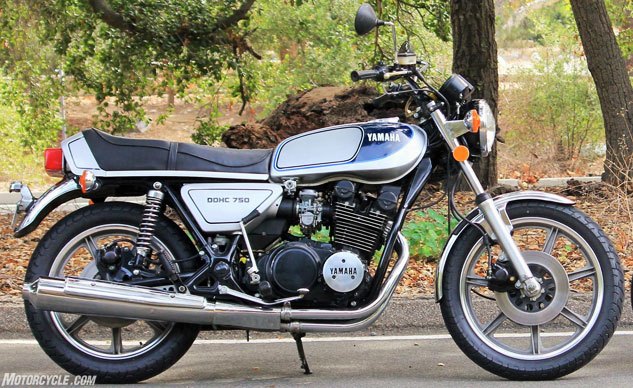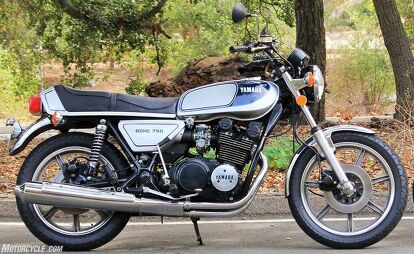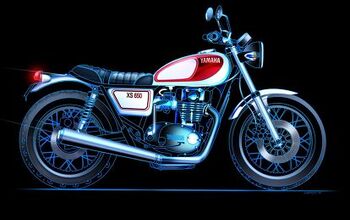Duke's Den: 1977 Yamaha XS750 Review (Of Sorts)
Number 834 is a blast from the past!
It’s impossible to be an editor of a moto publication without being a humongous fan of motorbikes. As such, I derive great pleasure from riding every new motorcycle that presents itself to me, and that attitude holds true even for non-new motorcycles, ones that I’ve never before thrown a leg over.
2017 Triumph Bonneville T100 First Ride Review
I was pleased to be among the first journalists in the world to have ridden Triumph’s new T100 Bonneville, which successfully attempts to bridge the gap from the decades-gone past to the Euro-4-approved future. The newest Bonneville brought the list of different bikes I’ve ridden to 833. That would be a lot if I were a younger man, yet I’m proud to have sampled such a rich panoply of two-wheeled contrivances no matter how long I’ve been orbiting the sun. Each machine has in its own way given me a seminar on motorcycle design, and each adds hints of color to what’s possible in in the way humans experience motorcycling.
Bike number 834 on my list brought me back in time to the genesis of my interest in things moto. I hadn’t ridden but a couple of minibikes back in 1977, but I was becoming aware of what I perceived to be cool streetbikes of the day. I remember being enthralled with the exciting two-stroke wail and perfect proportions of Yamaha RD400s, as well as the simplistic grace of Honda’s CB400 Four and its seductively sweeping exhaust headers.
An unholy love child of those Japanese sports roadsters might be, if you squint tightly, a 1977 Yamaha XS750. It borrowed design language from the RD Yamahas but uses a 747cc three-cylinder motor with sinuous exhaust headers somewhat akin to the 400 Four Honda.
The XS750 was the first more-than-two-cylinder streetbike engine from the tuning-fork brand as it tried to keep pace with the four-cylinder CB750 Hondas and 903cc Kawasaki Z1s from the early-to-mid-1970s. Setting the Yamaha apart was one fewer cylinder and the adoption of shaft drive to deliver power to its rear wheel. At that time, shaft-drive systems were almost exclusively available only from European manufacturers like BMW, Guzzi and MV.
The XS750 is really the progenitor of the modern three-cylinder Yamahas like the FZ-09, FJ-09 and XSR900, a trio of bikes we at MO admire for their capabilities and high smiles-per-dollar ratios, thanks in large part to the excitement derived from its engaging Triple. Most of what I know about Yamaha’s 1970s Triple I learned from the cool piece Troy Siahaan wrote that traces the lineage of Triples from Yamaha, but I recently had the chance for a behind-the-bars riding experience from an XS750.
I was near this lovely first-year XS750 to research a wonderful story about how a longtime Yamaha lover made a national search to find a vintage bike that always intrigued him but had escaped the grip of his knees for a variety of reasons. Incredibly, he found the excellent specimen seen here 3,000 miles away located in a small town in which he grew up!
That’s a tale for another day, but it’s the thread that brought the XS750’s seat between my legs for 30 or so miles on a recent sunny SoCal morning. Riding a three-cylinder XSR900 to my meeting with the XS750 was the perfect time capsule to step back in time to a Yamaha Triple from 40 years prior.
There are a few things in particular that draw distinctions from one generation to another after first sit. Its seat has what looks to be about six or more inches of cushy foam, a depth of padding not seen on typical modern bikes, resulting in a tallish-for-the-era 31.9-inch saddle height. Secondly, the older bike is amazingly narrow between the legs and has a low fuel tank. Finally, at around 550 pounds, the curb weight of the XS exceeds the XSR’s by almost 120 lbs.
More distinctions become apparent when fired up and moving down the road. The engine of the XS feels like it uses a heavy flywheel, as it picks up revs much slower than the XSR. Still, the motor and its 120-degree crank sounds largely similar to the XSR, but with a significantly lower rev limit of 7500 rpm. The XS’s driveline operates with a lack of refinement. Its clutch is grabby, and its gearbox requires unhurried and deliberate actions compared to anything modern. Ride modes are the responsibility of a rider’s wrist rotating the longest throttle turn I’ve ever experienced.
The XS is crude and anachronistic relative to the endlessly appealing XSR, but there is some commonality in the riding experience. The riding position is upright and comfortable, with a chrome handlebar angling back at an agreeable angle. A generous amount of low-end grunt delivers ample acceleration without trying hard, and power ramps up to a satisfying surge around 5500 rpm, accompanied by a tuneful exhaust note that reminds of an inline-Six Jaguar motor. It was rated by Yamaha at 64 horsepower, and there’s probably about 50 horses making their way through the shaft drive to the rear wheel.
Just as engine response from the XS is relatively slow, so are the responses from the steering. A lazy 27-degree rake delivers very stable directional stability at the cost of some agility. It’s not exactly truckish, but it prefers firm and smooth inputs to get it heeled over into corners. Power from the triple-disc brakes is underwhelming relative to modern kit. The front suspension proves to be surprisingly good, but the rear shocks seem to have lost some damping qualities over four decades. The thick seat helps cushion larger bumps.
Period bike reviews praise the XS750 for its lack of vibration, but its non-counterbalanced mill buzzes more intently than modern machines are allowed. Rubber-covered footpegs and rubber isolators for the handlebar take the edge off the buzz, although feeling the bar deflect during braking was a bit disconcerting.
Although the XS750 didn’t light the world on fire like the CB750 and Kawasaki Z1, there is a gentlemanly grace to Yamaha’s first Triple that melded Japanese modernity with a touring-oriented shaft drive nearly unique among Asian motorcycles of the day.
“Its strong appeal isn’t in the realm of muscle, but in nicety and finesse,” Cycle magazine described in a period review.
My personal review is colored by 40 years of technological progress, so XS750 feels behind the times compared to modern machines like the gloriously satisfying XSR900. But the old XS stimulates a rider’s senses in its own pleasing manner, and the smile I had on my face from riding it lasted for hours after I dismounted.
Now, where’s #835…?
1977 Yamaha XS750D Specifications | |
|---|---|
| Engine | 747cc, 3-cylinder, air-cooled, DOHC, 2-valve/cylinder |
| Transmission | 5-speed |
| Rake/Trail | 27.0 degrees/4.49 in. (114mm) |
| Wheelbase | 57.7 in. (1470mm) |
| Front Suspension | 38mm telescopic fork, 5.5 in. travel |
| Rear Suspension | Dual shocks with preload adjustability, 3.5 in. travel |
| Front Brakes | 267mm discs (2); single-piston caliper |
| Rear Brake | 267mm disc; single-piston caliper |
| Front Tire | 3.25-19 |
| Rear Tire | 4.00-18 rear |
| Length | 85.0 in. |
| Width | 38.0 in. |
| Height | 46.7 in. |
| Seat Height | 31.9 in. |
| Fuel capacity | 4.5 gallons |
| Dry Weight (claimed) | 470 lbs |
| Curb Weight (approx) | 550 lbs |
More by Kevin Duke








































Comments
Join the conversation
While judging its weight keep in mind there's a lot more metal on the old XS. I won't make the mistake of old timers that say, "Let's see how long these Modern Marvels last" but I'm tempted. I won't be around to see it but I doubt that someone will review an "Antique" FJ-09 in 40 years that hasn't been restored several times.
https://uploads.disquscdn.c...
Your piece brought back memories of my '78 750 Special. The photo was taken along I-40 riding back home to Alabama from Oklahoma in either '78 or '79. Loved that bike.